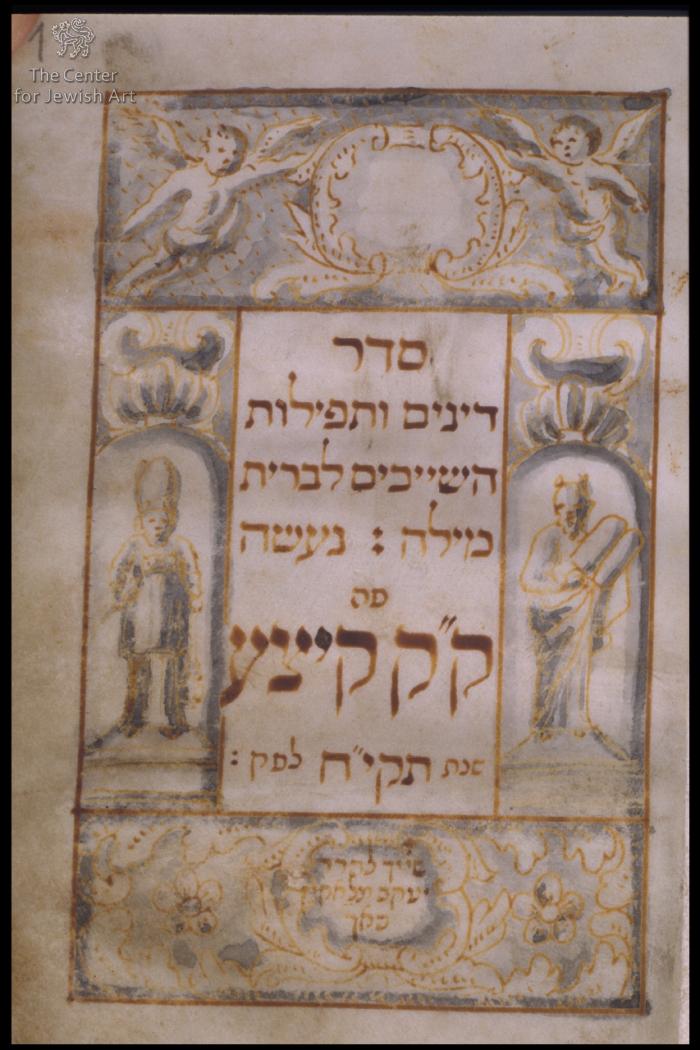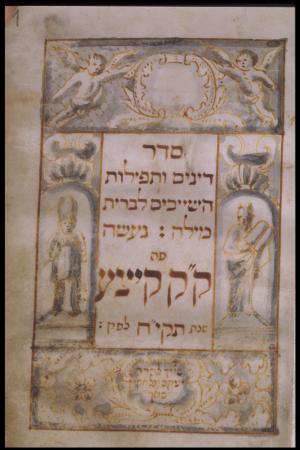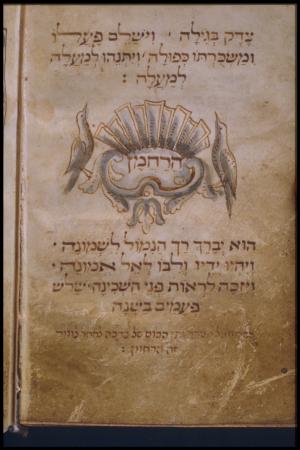Obj. ID: 1501
Hebrew Illuminated Manuscripts Vienna Seder Milah, Kittsee , 1758

This small Circumcision Service (Seder Brit Milah) manuscript is missing the last part of the verses recited before the ceremony, the all circumcision service and the beginning of Grace after Meals (see: Content).
The title-page of the manuscript (fol. 1) states that it was copied in Kittsee, near Pressbourg, in [5]518=1758 and belonged to Rabbi Jacob of Lackenbach, as indicated by the scribal inscription within the lower cartouche. The patron can be identified with Jacob ben Leser of Lackenbach, mentioned in the register (pinkas) of the community of Eisenstaadt (see: Cod. hebr. 222, Kat.-Nr. ##, No. 40, f. 130v; Wachstein, 1926, 70f. No. 40-40a), one of the most important communities of Europe at that time, and the leading of the "Seven communities" (Siebengemeinde) of Burgenland, which included Mattersburg (Mattersdorf), Lackenbach, Deutschkreutz (Tzelm?), Kobersdorf, Frauenkirchen and also Kittsee (Koepcseny ???), (at that time Hungary). In the pinkas it is recorded that Jakob b. Leser was admitted to that community on March 8th, 1751.
Although the scribe does not leave his name, the palaeographic and stylistic features of the manuscript indicate a strong resemblance to the hand of Hayyim ben Asher Anshel. Known to have been active as a teacher in Kittsee since 1725 (see: Monumenta Hungaria, 1974, XVI, 108), his activity as scribe and artist is testified between 1741 till 1782, two years before his death (according to his tombstone's inscription in the Jewish cemetery of Kittsee: April 20, 1784; see: Scheiber, Kittsee, 1980, p. 44, no. 2). Till now, twenty-seven manuscripts have been attributed to him, many of them also decorated (see: ibid. for complete bibliography).
The style of the decoration in the Viennamanuscripts is characterized by sketchy-like ink drawing with very few details both for human figures and architectonic and ornamental patterns, coloured in slight grey water-colour. Part of the drawing is outlined with dotted lines in the same tonality of brown ink. The same monochromatic and sketchy style is found in other manuscripts copied by Hayyim ben Asher Anshel in the same years, such as the Grace after Meals held in the collection of Robert Marx in Hilford, USA (Fig. #), dated 1753 (Fig. in Scheiber, 1980, fig. 4). Another stylistic comparison can be made with the manuscript including Kiddush, Grace after Meals and Blessings for various occasions (Private collection; formerly Amsterdam, M. H. Gans, No. 65; see Scheiber, 1966, table III, fig. 1 u. 2), also signed by the same scribe but undated (Fig. #), especially for the birds placed within the initial word panel, on fol. 2, similar to those flanking the initial word cartouche on fol. 7v of our manuscript. Presumably our scribe-artist was autodidact and used printed patterns, as is evident from the only one richly illustrated Passover Haggadah copied in Vienna in 1748 (William L. Gross Collection, Ramat Aviv, Israel, no. 17), and for whose illustration Asher Anshel used printed patterns from the iconographic traditions of the Amsterdam (1712) and the Venetian (1609) Haggadot (see Scheiber, 1980, 45).
This manuscript, produced by one of the leader scribes-artists in Kittsee for a prominent figure, Rabbi Jacob (ben Lezer) of Lackenbach, is a precious witness of the prolific cultural and Jewish life in the Burgenland. The mid 18th century represented a period of high revival of the art of Hebrew manuscripts decoration that flourished in Central and Eastern Europe since the beginning of the century till the early 19th century.
At least before 1974 the manuscript was in the collection Rabbi Yaakov Schwarz, whose ex-libris can be found on fol. IIIv (see: History). On October 15, 1974, the manuscript was auctioned off in Sotheby’s (Parke Bernet Public Auction, cat. No. 326) and then (Andreas, please check the date of the donation/purchase of the ms) reached the Austrian National Library through a private owner. The pencil-page-numbers and the entry on fol. 1 Restauro refer to an older restoration (of the 20th century) inItaly.
sub-set tree:
Text space: (92-94) X ca. 55 mm.
Material: Parchment, I + II + 10 + I leaves
Measurements
|
Full page: (14-17) X ca.77 mm. |
|
Text space: (92-94) X ca.55 mm. |
Scribes
One single scribe:
|
Hayyim ben Asher Anshel |
Main text and instructions |
fols. 1-10v. |
Script
|
Main text written in square Ashkenazi script, in different sizes, in brown and light brown ink. |
|
Instructions in Hebrew and Yiddish written in small semi-cursive Ashkenazi script in brown ink. |
|
Four initial words written in larger square Ashkenazi script in darker brown ink (fols. 1v, 7v, 8, 9v) |
|
|
Number of lines
|
Main text: |
15 (fols. 1v-3v) – 17 (fols. 5-7) |
Ruling
The original ruling in plummet, today no discernible except for fol. 10v.
Pricking
Pricking is discernible along the outer margins of the text space (fols. 1, 4, 5, 8, 9, 10).
Quires
Three quires, one of 4 leaves and two of 3 leaves. Missing text between quires 1 and 2 (between fols. 3v and 4), indicates that at least one leave with text is missing. Considering the large part of text missing (all the service for the circumcision), it seems that an entire quire is missing.
: I2+1 (fol. 3 is a widow; a stub is discernible on fol. 1; missing text).
II4
III1+2 (fol. 8 is a widow; a stub is discernible on fol. 10v, no text is missing)
Catchwords
On fol. 2v one catchword for leave is written horizontally on the lower-left corner of the page.
Hebrew numeration
None
Blank leaves
None
Binding: 124 X 84 X12-13 mm
Box: 136 X 90 X29 mm.
Black leather binding with blind-tooled designs of a foliate scroll motif interspersed with fruit (pomegranates?) and flowers on either side. The manuscript is kept in a brown leather box, decorated with 49 (7x7) compartments of alternating tooled rosettes and fleurs-de-lis. Stamped on the spine, in gold letters:
"Seder Milah, Kittsea, [5]518"
The decoration was made close to the writing of the text by the scribe himself. It consists of one title-page (fol. 1) and of four initial word panels; all executed in light brown ink, and filled in monochrome light gray shadows.
- One title-page: with figures of Moses and Aharon flanking the central panel with the title inscription (fol. 1)
- Four initial words panels: written within elaborated cartouches, (fols. 1v, 8, 7v, 9v), decorated with floral scrolls one unframed (fol. 7v), but decorated with cartouches, foliate scrolls, flowers and birds.








